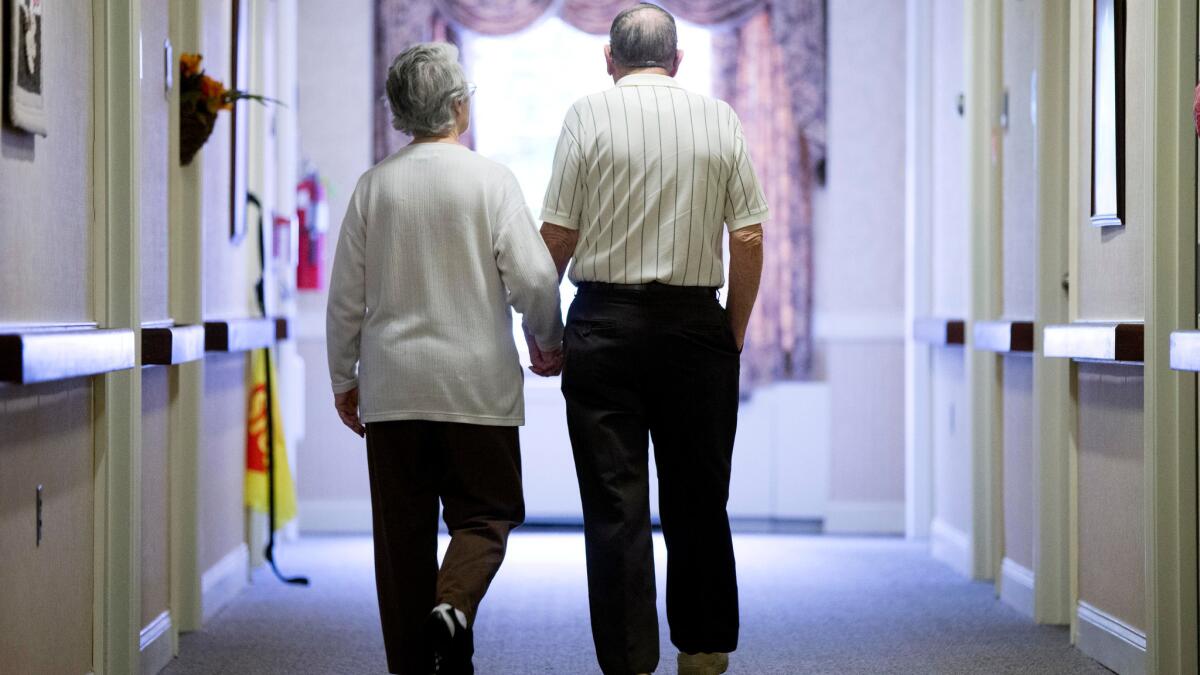Op-Ed: Gray divorce: Why your grandparents are finally calling it quits

Alicia P., 66, an artist, has been married to her physician husband, Chet, 68, for 42 years. The couple had long had problems with intimacy, and Alicia complained that Chet was so involved with his medical research that family came a distant second. As long as their children were at home, Alicia thought about divorce from time to time, but believed the couple had to stay together âfor the kids.â
Now that the kids are out of college and starting families of their own, however, Alicia has asked Chet for a divorce. Her parents lived into their 90s, Alicia is in good health, and the idea of spending another 25 years in her unsatisfying marriage is simply not appealing.
Alicia and Chet are not alone. As Evergreen State University professor Stephanie Coontz comments, âIf you are a healthy 65, you can expect a pretty healthy [next] 20 yearsâ¦. It seems more burdensome ... to stay in a bad relationship, or even one that has gone stale.â
Still, thereâs a tendency to think that divorce is for the young â those who jumped quickly into marriage, unprepared for the scale of the commitment or the strain of raising children. Once couples have made it past these hurdles, and past midlife crises as well, they are often considered to be in the clear, at no risk of divorce. These marriages, we think, dissolve only when one partner dies. But statistics donât bear that out.
A half-century ago, only 2.8% of Americans over 50 were divorced. Today, that figure is more than 15%.
Overall divorce rates have begun to decline, but the rate among older Americans has more than doubled since 1990. A half-century ago, only 2.8% of Americans over 50 were divorced. Today, that figure is more than 15% with approximately 1 in every 4 divorces occurring among couples over 50.
There are a number of reasons why âgray divorceâ is on the rise. Perhaps chief among them is the simple fact that Americans are living longer and healthier than ever before. According to a recent Harvard study, between 1992 and 2008, life expectancy for those aged 65 increased from 17.5 years to 18.8 years, and more than 10 of those years were disability free.
It stands to reason that our increased longevity, combined with wide acceptance of divorce, will mean weâll see more 50-, 60- and 70-year marriages â and more of them ending as well. Couples are simply at risk of divorce for more years than couples were in the past.
Late adult marriages may also be second or third unions, which puts them at particular risk â those marriages are 2.5 times more likely to end than first marriages.
Another factor is the effect of the baby boom. That generation was the first to see a major increase in women in the workplace. Now, as they enter retirement age, some wives are in much better financial shape than their mothers were. Their economic independence means they may be much more willing to go it alone.
Attitudes and finances may ease the way toward divorce for older couples,but late-blooming divorce also carries with it some disadvantages. Divvying up assets later in life, and grappling with the fixed incomes that come with retirement, add complexity (there are separate websites about the legal issues facing those seeking a gray divorce).
And while adult children may actually be relieved to see their parents end an unhappy marriage, there are also indications that relations with adult children can suffer, with less contact, less closeness and more tension. Studies show this is especially true for divorced fathers.
Gen-Xers who have established their own families may be in a particular bind. Theyâll be facing a big change in grandparent dynamics: having to choose which parent to ask over for family Thanksgivings, Christmases, Hanukkahs and other holidays, and which parent to invite on family vacations, or bring to school plays and recitals.
But there can be surprising family upsides to late divorce as well. Katie Crouch wrote in the New York Times that at 72, after 45 years of a difficult marriage, her mother divorced and set up a separate household. Crouchâs 4-year-old daughter was the clear winner. She is getting lots of attention: âAll of the spoils, none of the pain.â Now that her grandparents live separately, âshe has been in hot demandâ with constant phone calls and regular Skyping sessions.
If trends continue, according to the National Center for Family and Marriage Research, the number of middle-aged people who will experience divorce in 2030 will climb by about 10,000, but among older adults, it will increase by about 80,000. A lot of us are living longer, but our marriages arenât.
Rosalind C. Barnett and Caryl Rivers are the authors of âThe Age of Longevity â Reimagining Tomorrow for Our New Long Lives.â
Follow the Opinion section on Twitter @latimesopinion and Facebook
More to Read
A cure for the common opinion
Get thought-provoking perspectives with our weekly newsletter.
You may occasionally receive promotional content from the Los Angeles Times.










